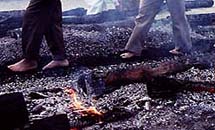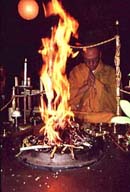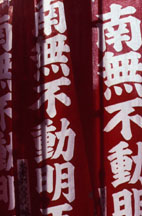Fire Walk at Saba Daishi
Achtung: Sie sehen eine veraltete Version von https://religion-in-japan.univie.ac.at/Handbuch/Alltag/Pilgerschaft/Fire_walk.

Text and fotos © Don Weiss
I visited Saba Daishi [...] on the day of the temple's semi-annual Fire Walk. I got there early, but merchants were already setting up stalls to sell souvenirs and antiques. The ladies of the parish were preparing lots of tea and noodles that, later, were given to the 300 or so people who came to the ceremony. Mean·while, the priests were preparing a sacred enclosure for the big outdoor goma that would end with nearly the whole village walking barefoot behind the priests along a five meter path of hot coals.
All goma services are basically the same, though they vary in length, setting, and the principal deities involved. More than three thousand years ago, Vedic priests of ancient India sat before altars, mentally created a sacred space, and invited Agni, the Fire God, to enter the space and consume grain, oil, and other symbolic offerings. Mahayana Buddhism adopted this fire ceremony. I once saw a goma in Lhasa that was little different from what I saw in Shingon temples on Shikoku, at the sect's head·quarters at Koyasan, and in the many cave temples on the island of Shodoshima in the Inland Sea.
As soon as the sacred space was prepared for the goma that would end with the fire walk, the head priest went to the Fudo Hall, where he performed an indoor goma. It was, as always, an exciting, moving performance. Even in the modern goma halls favored by priests who don't want to burn down their temples, goma services call every sense to attention.

The service begins with chanting accompanied by powerful drumbeats that call to the body with a coital rhythm. Faster and louder the drum beats. Incense fills the air. Then, as the fire is lit, the smell of the burning wood, the sharp crackle of the sparks, and the heat pouring from the fire bring attention to fever pitch. When the fire is at its height, the drum swells with power and seems to explode in the hall, echoing with spasmodic relief. During all this excitement, the congregation chants the Heart Sutra. Now, as the fire dies to smoke, the priest turns and gives a brief sermon, then invites everyone to walk around the fire. Most people wave their hands in the curling smoke and rub the smoke on some part of their body in need of blessing. I usually rubbed my head, the usual modest gesture of desiring wisdom. After I broke my kneecap in a traffic accident, I also started rubbing the knee. [...] Afterwards, the priests held another ceremony, this one in the Hon-do. Next we all had lunch. Then it was time to begin the outdoor goma.

All the priests marched in procession from the Hon-do. First came the head priest, accompanied by an assistant holding a golden umbrella over his head. After him came the yamabushi. They are a kind of semi-ordained priesthood. They have their own costumes and rituals, some of which date back to pre-Buddhist cults of mountain deities. Other priests followed, then the people of the village. The head priest stood aside at the entrance to the sacred enclosure and the oldest yamabushi stepped forward. He performed a brief ritual to open the enclosure, then led the way inside, followed by the other yamabushi and priests.
There followed a series of ritual acts, all aimed at the consecration of the place, the persons involved, and the offerings to be placed on the fire. First, the old yamabushi threw salt out from the corners of the enclosure. Then he shot white arrows. People scrambled to pick them up. The lucky ones brought them to the head priest. He had them stand in a group, waiting for their moment of honor, later, when the fire was ready.
The fire was lit by the old yamabushi using a flaming arrow. Then the head priest took over the ritual while the fire grew. The fire for this ceremony was the largest I've ever seen at a goma. Before it was lit, the wood was piled three meters square and four meters high. When it was fully flaming, the heat drove most of the spectators back from the white cord surrounding the enclosure. [...] The air was filled with the aroma of cedar, the sting of acrid smoke, the clatter of sparks and the voices of priests chanting, people talking, village dogs barking. A plume of smoke rose and waved in the breeze, sometimes blocking the sun and turning the day to dusk. I looked up but I couldn't see the top of the plume. Roaring flames turned the logs to smoke, like the glow of a burning stick of incense multiplied by a million.
Gradually, the pyre flamed higher, then burned low. Then the younger priests attacked it with poles and long rakes, pulling it apart, spreading it out, preparing it for the next part of the ritual. The next offerings were to be of faith, entrusting the body to the coals. The head priest and the yamabushi carefully supervised this. They made sure it was safe. When one spot continued to burn, the head priest carried over a bucket of water waiting nearby and sprinkled the coals into a dull glow.

Finally, all was ready. The old yamabushi again took the lead. He sat a few feet from the edge of the coals and prayed intently. Then he stood up and walked across the coals. After about four meters, he stumbled and almost fell. He crossed the last meter of fire quickly, then stood on the mat of green cedar boughs sprinkled with salt and water that had been prepared at the end of the glowing path. He grinned. The head priest came next. He walked with even steps but a little faster than the old yamabushi. He made it across safely. Next came the other yamabushi and priests. Then the villagers who had found the white arrows.

A little girl about six years old stood in this group, holding one of the arrows. She smiled happily as the people in front of her walked across the fire. The head priest waited at the far side. As each person reached him, he gave a blessing and made sure they stood for a moment on the cool green mat of wet cedar branches that he had prepared. When the little girl stepped onto the coals, her smile vanished, and her eyes opened wide in surprise and horror. The priest called to her and she ran slowly across the coals, lifting her feet high to keep them off the coals as much as she could. At the far side, she broke into tears. The head priest comforted her with a smile and a hug. Her grandmother came up and spoke to her, laughing. [...]
Source: http://www.davidmoreton.com/echoes/09.html
Reproduced by courtesy of the author, Don Weiss
Religion in Japan, Inhalt
- 一 Grundbegriffe
- 二 Bauten
- 五 Mythen
- Einleitung
- Mythologie:
- Götter des Himmels
- Götter der Erde
- Jenseits:
- Jenseits
- Geister:
- Totengeister
- Dämonen
- Tiere:
- Imaginäre Tiere
- Verwandlungskünstler
- Symboltiere
- 六 Geschichte
- Einleitung
- Altertum:
- Prähistorie
- Frühzeit
- Nara-Zeit
- Frühe kami-Kulte
- Heian-Zeit
- Saichō
- Kūkai
- Honji suijaku
- Mittelalter:
- Kamakura-Zeit
- Amidismus
- Zen Buddhismus
- Nichiren Buddhismus
- Mittelalterl. Shintō
- Frühe Neuzeit:
- Reichseinigung
- Christentum
- Terauke-System
- Neo-Konfuzianismus
- Kokugaku
- Moderne und Gegenwart:
- Bakumatsu-Zeit
- Staatsshintō
- Neue Religionen
- 七 Essays
- Überblick
- Buddhismus, Asien:
- Arhats in China und Japan
- Vajrapani: Der Feldherr des esoterischen Buddhismus
- Bishamon-ten: Wächter und Glücksgott
- Riesen-Buddhas: Im Kampf gegen die Unbeständigkeit des irdischen Daseins
- Lokale Vorstellungen, Japan:
- Jindō und shintō: Zum Begriffsinhalt des ‚Weges der kami‘
- Ōkuninushi als heimlicher Gegenspieler der Himmlischen Götter
- Religiöse Gewalt in Japan: Blutopfer, Selbstopfer, Menschenopfer
- Unterhändler des Imaginären: Regenmachen im vormodernen Japan
- Lieber das Herz in der Hand als die Taube über dem Heer
- Feuer mit Feuer bekämpfen: Der Gehörnte Meister und sein Kult
- Hundert Geschichten: Horrorklassiker aus der Edo-Zeit
- Religion und Politik:
- Die Tenshō-Mission: Beginn einer schwierigen transnationalen Beziehung
- Yasukuni: Der Schrein des ‚friedlichen Landes‘
- Herrigels Zen und das Bogenschießen
- Anhang
- Metalog
- Konzept
- Autor
- Impressum
- Glossare
- Fachbegriffe-Glossar
- Bilder-Glossar
- Künstler-Glossar
- Geo-Glossar
- Ressourcen
- Literatur
- Links
- Bildquellen
- Suche
- Suche
- Feedback
- Anmelden
„Feuer-Gang auf dem Berg Takao.“ In: Bernhard Scheid, Religion-in-Japan: Ein digitales Handbuch. Universität Wien, seit 2001